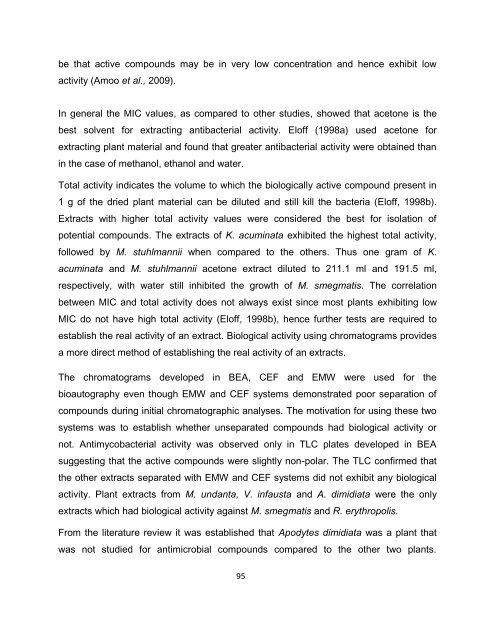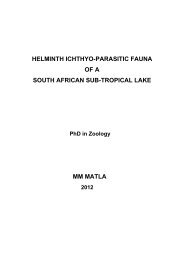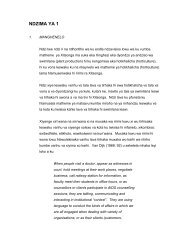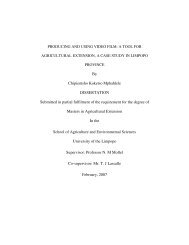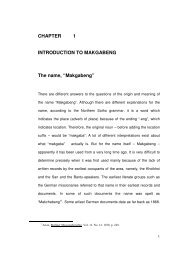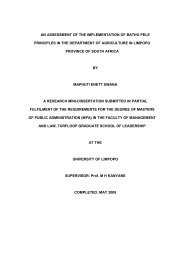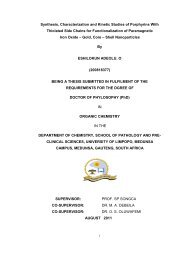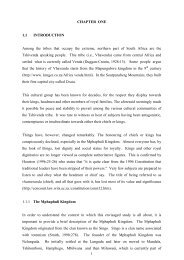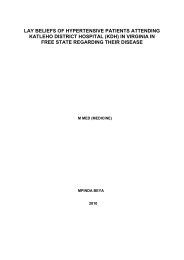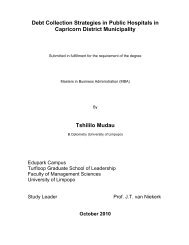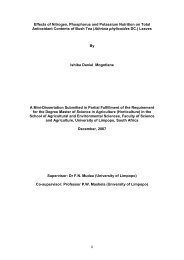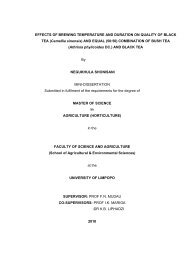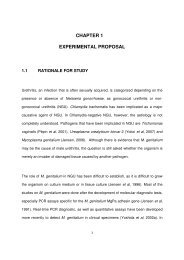Mmushi T MSc (Microbiology).pdf
Mmushi T MSc (Microbiology).pdf
Mmushi T MSc (Microbiology).pdf
You also want an ePaper? Increase the reach of your titles
YUMPU automatically turns print PDFs into web optimized ePapers that Google loves.
e that active compounds may be in very low concentration and hence exhibit low<br />
activity (Amoo et al., 2009).<br />
In general the MIC values, as compared to other studies, showed that acetone is the<br />
best solvent for extracting antibacterial activity. Eloff (1998a) used acetone for<br />
extracting plant material and found that greater antibacterial activity were obtained than<br />
in the case of methanol, ethanol and water.<br />
Total activity indicates the volume to which the biologically active compound present in<br />
1 g of the dried plant material can be diluted and still kill the bacteria (Eloff, 1998b).<br />
Extracts with higher total activity values were considered the best for isolation of<br />
potential compounds. The extracts of K. acuminata exhibited the highest total activity,<br />
followed by M. stuhlmannii when compared to the others. Thus one gram of K.<br />
acuminata and M. stuhlmannii acetone extract diluted to 211.1 ml and 191.5 ml,<br />
respectively, with water still inhibited the growth of M. smegmatis. The correlation<br />
between MIC and total activity does not always exist since most plants exhibiting low<br />
MIC do not have high total activity (Eloff, 1998b), hence further tests are required to<br />
establish the real activity of an extract. Biological activity using chromatograms provides<br />
a more direct method of establishing the real activity of an extracts.<br />
The chromatograms developed in BEA, CEF and EMW were used for the<br />
bioautography even though EMW and CEF systems demonstrated poor separation of<br />
compounds during initial chromatographic analyses. The motivation for using these two<br />
systems was to establish whether unseparated compounds had biological activity or<br />
not. Antimycobacterial activity was observed only in TLC plates developed in BEA<br />
suggesting that the active compounds were slightly non-polar. The TLC confirmed that<br />
the other extracts separated with EMW and CEF systems did not exhibit any biological<br />
activity. Plant extracts from M. undanta, V. infausta and A. dimidiata were the only<br />
extracts which had biological activity against M. smegmatis and R. erythropolis.<br />
From the literature review it was established that Apodytes dimidiata was a plant that<br />
was not studied for antimicrobial compounds compared to the other two plants.<br />
95


